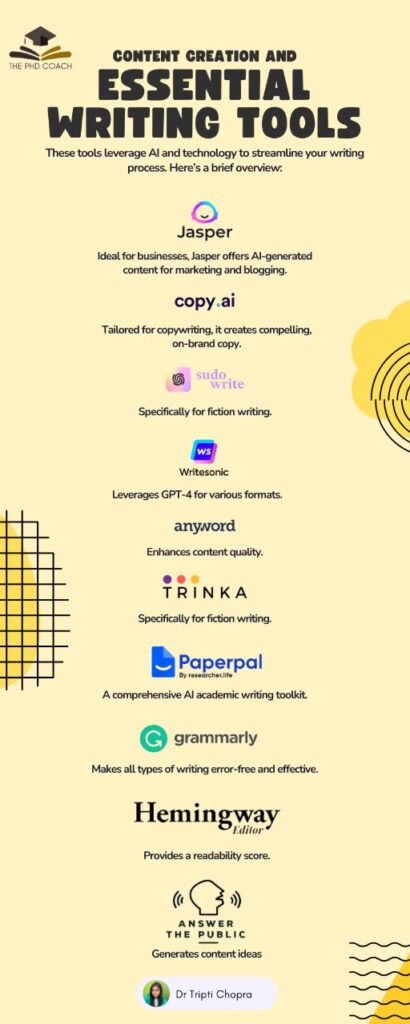
In an era where content creation and academic writing are increasingly competitive, leveraging AI-powered writing tools can significantly enhance efficiency, creativity, and precision. Whether you’re a marketer, a blogger, a fiction writer, or a researcher, these tools simplify the process of drafting, editing, and refining your work, allowing you to focus on creativity and critical thinking.
In this blog, we’ll dive deep into some of the most popular writing tools—Jasper, Copy.ai, Sudowrite, Writesonic, Trinka, Paperpal, Grammarly, Hemingway Editor, and Answer the Public—exploring their features, use cases, and how they can transform your writing process.
1. Save Time
AI-powered tools automate repetitive tasks like grammar checking, formatting, and idea generation, leaving you more time to focus on research and creativity.
2. Enhance Precision
With advanced algorithms, these tools help eliminate grammatical errors, improve sentence structure, and ensure readability.
3. Foster Creativity
Many tools generate ideas, suggest alternative phrasing, and even create drafts based on prompts, giving you the creative boost you need.
Jasper (formerly Jarvis) is a powerful AI writing assistant designed for content creators, marketers, and businesses. It excels at generating SEO-friendly content for blogs, websites, and advertisements.
Features
Use Case
Marketers can use Jasper to create engaging blog content that ranks well on search engines or to craft compelling ad copies with minimal effort.
If you’re a brand looking to create persuasive, on-point copy, Copy.ai is your go-to tool. It’s tailored for creating marketing content that aligns perfectly with your brand voice.
Features
Use Case
E-commerce businesses can quickly create product descriptions that highlight features and benefits, saving hours of manual writing.
Sudowrite is specifically designed for fiction writers, offering assistance with storylines, character development, and creative phrasing.
Features
Use Case
Novelists and screenwriters can use Sudowrite to refine their narratives and overcome writer’s block with fresh ideas.
Writesonic leverages GPT-4 technology to assist in creating content across a wide range of formats, from blogs and ad copies to essays and product descriptions.
Features
Use Case
Entrepreneurs can use Writesonic to draft marketing content for websites and social media campaigns, ensuring their messaging is sharp and effective.
Trinka stands out as a tool designed specifically for improving academic and technical documents. It ensures clarity and precision in research papers and scientific articles.
Features
Use Case
Researchers can use Trinka to polish their manuscripts before submission to journals, ensuring error-free, high-quality academic writing.
Paperpal is another AI tool dedicated to academic writing, focusing on research papers, theses, and essays. It provides real-time feedback and corrections.
Features
Use Case
Ph.D. students can use Paperpal to edit their dissertations, ensuring the work meets academic standards while maintaining originality.
Grammarly is one of the most popular tools for improving grammar, spelling, and clarity in all types of writing, from emails to essays.
Features
Use Case
Anyone—from students to professionals—can use Grammarly to proofread their work, ensuring error-free and polished output.
Hemingway Editor is designed to enhance readability by simplifying complex sentences and improving overall flow.
Features
Use Case
Writers can use Hemingway Editor to create concise, engaging content for blogs, reports, or essays.
Answer the Public helps content creators generate ideas by analyzing popular questions and search terms related to their topic.
Features
Use Case
Bloggers can use this tool to identify trending topics and structure their content around what their audience is searching for.
Many of these tools offer free versions, but premium features might require a subscription. Evaluate your budget and the value each tool provides.
Ensure the tool integrates with your existing workflow. For example, some tools work seamlessly with Google Docs or Microsoft Word.
While these tools are powerful, they do have limitations:
AI writing tools like Jasper, Copy.ai, Sudowrite, Writesonic, Trinka, Paperpal, Grammarly, Hemingway Editor, and Answer the Public are revolutionizing the way we write. Whether you’re drafting a blog post, writing a novel, or polishing an academic paper, these tools streamline the process, boost efficiency, and elevate your output.
Choosing the right tool depends on your needs, whether it’s creating persuasive marketing content, simplifying technical writing, or ensuring grammatical accuracy. By incorporating these tools into your workflow, you can focus on what truly matters: crafting impactful, original content.
1. Are these tools beginner-friendly?
Yes, most tools offer user-friendly interfaces, making them accessible even to beginners.
2. Are there free versions available?
Yes, many tools like Grammarly, Writesonic, and Hemingway Editor offer free versions with basic features.
3. Can these tools replace manual proofreading?
While they are highly effective, a human touch is always recommended for nuanced edits.
4. Which tool is best for academic writing?
Trinka and Paperpal are specifically designed for academic and technical writing.
5. How do I know if a tool is right for me?
Identify your specific writing needs, test free versions, and evaluate how well they integrate with your workflow.

Dr. Chopra is the founder and editor of thephdcoaches.blogs and Thephdcoaches Learn more about her here and connect with her on Instagram, Facebook and LinkedIn.
Dr. Tripti Chopra, founder of The PhD Coach, is an award-winning mentor and leader in integrating AI into academic research, with over a decade of experience guiding PhD students and researchers. Her work revolutionizes research processes, promotes sustainable writing practices, and inspires scholars to embrace technological advancements.
Copyright© 2023 Thephdcoach All rights reserved.
Leave a Comment